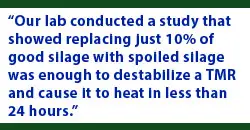
Spoiling silages and TMRs
 By Dr. Limin Kung, University of Delaware professor of animal and food sciences
By Dr. Limin Kung, University of Delaware professor of animal and food sciencesSilages start to spoil when exposed to air. Air stimulates the growth of spoilage yeasts that degrade lactic acid, which results in a rise in pH, heating, and degradation of nutrients in the silage mass. Because total mixed rations (TMR) contain silages, they are also prone to further spoilage in the feed bunk.
Our lab has measured TMR temperatures as high as 120 to 130 degrees F after less than 24 hours of being exposed to air. Issues with spoiling silages and TMRs are usually more common during warmer weather because detrimental yeasts are more active under these conditions. In a two-year survey, we collected TMR samples from Delaware dairy farms in the summer months to examine aerobic stability. Any TMRs that heated up in less than 12 hours after being exposed to oxygen were considered aerobically unstable. In the first year, samples from eight of 12 farms were considered aerobically unstable, and, in the second year, eight of 18 farms were considered aerobically unstable.
The consequences of feeding a spoiling TMR to dairy cows depends on several factors, including the degree of spoilage and the stage of lactation the animals are in (early lactation cows may be more susceptible to negative effects). The most obvious potential consequence is a decrease in intakes, which could translate into a decrease in milk production. It is unknown exactly why intakes decline, but it could be due to taste, smell, the heating itself, and negative chemical components affecting the rumen and/or the cow. In some instances, the TMR may be slightly warm and just beginning to spoil, resulting in no measurable negative effect on the animals. In a worst-case scenario, feeding a very spoiled TMR may decrease intakes by more than 10% to 15%.
 The first step to prevent a TMR from potentially spoiling is using fresh silage with good aerobic stability. A research-proven inoculant will improve aerobic stability, but achieving an adequate packing density and using an oxygen barrier plastic will also help. If you decide to mix a TMR with silage that is already spoiling, a TMR preservative can help slow or stop further spoilage in the feed bunk, but I consider this a “Band-Aid® approach.”
The first step to prevent a TMR from potentially spoiling is using fresh silage with good aerobic stability. A research-proven inoculant will improve aerobic stability, but achieving an adequate packing density and using an oxygen barrier plastic will also help. If you decide to mix a TMR with silage that is already spoiling, a TMR preservative can help slow or stop further spoilage in the feed bunk, but I consider this a “Band-Aid® approach.”
In some instances, other feeds may be adding to the instability of a TMR. For example, mixing even small amounts of badly deteriorated wet brewer’s or distiller’s grains into a TMR could be enough to cause it to spoil, even if the silage sources were fresh and stable. The practice of mixing leftover TMR into the next day’s feed, or feeding it to heifers, should be done with caution and it will depend on the degree of spoilage and environmental temperatures. Our lab conducted a study that showed replacing just 10% of good silage with spoiled silage was enough to destabilize a TMR and cause it to heat in less than 24 hours.
In conclusion, to minimize potentially negative effects on intakes and production, producers should strive to feed the freshest and most stable silages available.
| Category: |
Animal health Feed quality and nutrition Forage Foundations |

